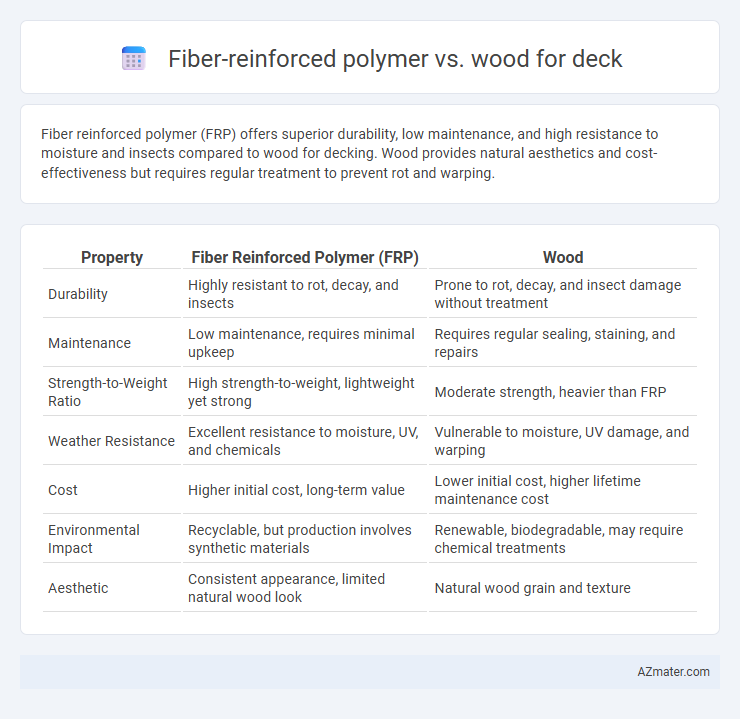Fiber reinforced polymer (FRP) offers superior durability, low maintenance, and high resistance to moisture and insects compared to wood for decking. Wood provides natural aesthetics and cost-effectiveness but requires regular treatment to prevent rot and warping.
Table of Comparison
| Property | Fiber Reinforced Polymer (FRP) | Wood |
|---|---|---|
| Durability | Highly resistant to rot, decay, and insects | Prone to rot, decay, and insect damage without treatment |
| Maintenance | Low maintenance, requires minimal upkeep | Requires regular sealing, staining, and repairs |
| Strength-to-Weight Ratio | High strength-to-weight, lightweight yet strong | Moderate strength, heavier than FRP |
| Weather Resistance | Excellent resistance to moisture, UV, and chemicals | Vulnerable to moisture, UV damage, and warping |
| Cost | Higher initial cost, long-term value | Lower initial cost, higher lifetime maintenance cost |
| Environmental Impact | Recyclable, but production involves synthetic materials | Renewable, biodegradable, may require chemical treatments |
| Aesthetic | Consistent appearance, limited natural wood look | Natural wood grain and texture |
Introduction to Decking Materials
Fiber reinforced polymer (FRP) decking offers superior durability, resistance to moisture, and low maintenance compared to traditional wood decking. Wood provides natural aesthetics and is often preferred for its cost-effectiveness and ease of installation but is susceptible to rot, insect damage, and requires regular upkeep. Choosing between FRP and wood depends on factors such as climate, budget, desired lifespan, and maintenance preferences.
Overview of Fiber Reinforced Polymer (FRP) Decking
Fiber Reinforced Polymer (FRP) decking offers superior durability, resistance to moisture, rot, and insect damage compared to traditional wood decking. Composed of high-strength fiberglass combined with polymer resins, FRP decking provides a lightweight yet strong alternative, reducing maintenance requirements and increasing lifespan. Its non-porous surface and UV resistance enhance longevity, making it an ideal choice for outdoor environments exposed to harsh weather conditions.
Key Characteristics of Wood Decking
Wood decking offers natural aesthetics, with rich textures and grains that enhance outdoor spaces. It provides excellent workability, allowing for easy customization, cutting, and fastening. However, wood requires regular maintenance to prevent rot, insect damage, and weathering compared to fiber reinforced polymer (FRP), which is more durable and low-maintenance.
Durability Comparison: FRP vs Wood
Fiber reinforced polymer (FRP) decks offer superior durability compared to wood, resisting rot, decay, and insect damage that commonly affect wooden decks. FRP materials maintain structural integrity under harsh weather conditions and require minimal maintenance, unlike wood, which often needs regular sealing, staining, or replacement of damaged boards. The longevity of FRP decks, often exceeding 25 years with minimal upkeep, outperforms traditional wood decks, which typically last 10-15 years before significant repairs are necessary.
Maintenance Requirements
Fiber reinforced polymer (FRP) decks demand significantly less maintenance compared to traditional wood decks, as they resist rot, insect damage, and warping without the need for regular sealing or staining. Wood decks require frequent treatments such as sanding, staining, and sealing to prevent moisture damage, decay, and UV deterioration, increasing long-term upkeep costs. FRP materials also eliminate splintering and fading issues, providing a durable, low-maintenance solution ideal for outdoor decking applications.
Aesthetic Appeal and Design Flexibility
Fiber reinforced polymer (FRP) offers superior design flexibility compared to wood, allowing for customizable shapes, colors, and finishes that mimic natural textures while providing consistent aesthetic appeal. Wood delivers a classic, warm appearance with natural grain patterns unique to each piece, but it requires regular maintenance to preserve its look. FRP decks resist fading, warping, and insect damage, ensuring long-lasting beauty with minimal upkeep, making them ideal for versatile and enduring design applications.
Environmental Impact and Sustainability
Fiber reinforced polymer (FRP) decks offer enhanced durability and resistance to moisture, reducing the need for frequent replacements and minimizing waste compared to traditional wood. Wood decks, sourced from sustainably managed forests, provide a renewable and biodegradable option but require chemical treatments that may impact ecosystems. Lifecycle assessments indicate FRP's longer lifespan offsets its higher initial carbon footprint, while wood's carbon sequestration during growth contributes positively to its overall environmental profile.
Installation Process and Complexity
Fiber reinforced polymer (FRP) decking offers a simplified installation process due to its lightweight materials and pre-manufactured components, reducing labor time compared to traditional wood decks. Unlike wood, which requires precise cutting, sealing, and regular maintenance during installation, FRP panels often feature interlocking designs and pre-drilled holes that streamline assembly and minimize errors. The complexity of installing wood decks increases with the need for moisture control and warping prevention techniques, whereas FRP resists these issues, making it a more straightforward choice for consistent and durable deck construction.
Cost Analysis: Initial and Long-Term Expenses
Fiber reinforced polymer (FRP) decking typically involves higher initial costs compared to traditional wood due to material expenses and specialized installation requirements. Long-term expenses favor FRP as it resists rot, insect damage, and weathering, significantly reducing maintenance, repair, and replacement costs over time. Wood decks demand regular sealing, staining, and potential structural repairs, increasing total lifecycle costs compared to the durable and low-maintenance nature of FRP.
Best Applications: Choosing the Right Material for Your Deck
Fiber reinforced polymer (FRP) is ideal for decks exposed to harsh weather, high moisture, or heavy foot traffic due to its superior durability, low maintenance, and resistance to rot, mold, and insect damage. Wood offers a natural aesthetic and is best suited for shaded or covered decks where regular sealing and maintenance are feasible to prevent decay and warping. Selecting FRP ensures long-term performance in challenging environments, whereas wood remains a cost-effective, eco-friendly choice for traditional, visually warm outdoor spaces.

Infographic: Fiber reinforced polymer vs Wood for Deck
 azmater.com
azmater.com